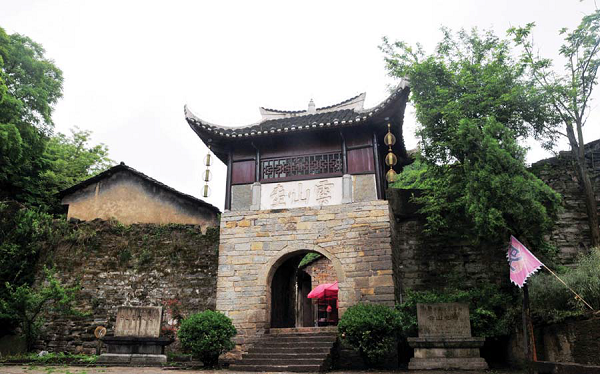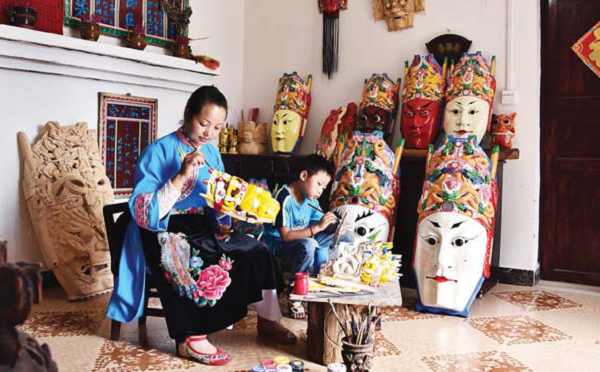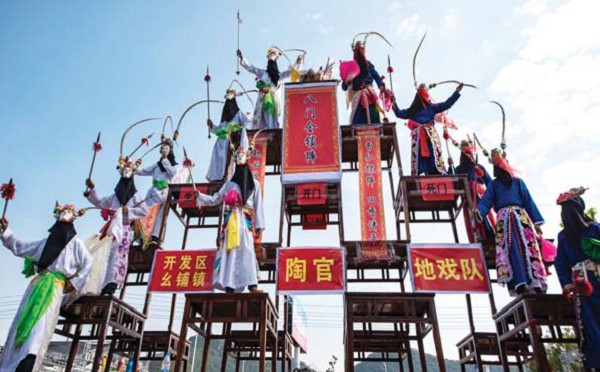
The Yunfeng Tunpu Culture Tourism Area is an ancient military outpost that today attracts armies of tourists.
In 2016, nearly 540,000 travelers visited the cluster of eight ancient tunpu villages about 20 kilometers outside Anshun city in Southwest China's Guizhou province. Tunpu were military outposts where soldiers guarded the region and cultivated the land.
Each of the villages nestled inside a stone wall has watchtowers. The settlements were designed to not only ward off attacks individually but also to support one another in times of need.
The first Ming Dynasty (1368- 1644) emperor Zhu Yuanzhang defeated the last Yuan Dynasty (1271- 1368) troops in today's Yunnan province in Southwest China to unify the country. He then stationed a huge force in Anshun — a strategic military position — to ensure regional peace. The garrison grew grain and also engaged in trade.
The villagers are the descendants of ethnic Han soldiers originally from south of the Yangtze River, including East China's Jiangsu and Anhui provinces.
Their dialect, attire, diet and customs have changed little over the centuries.
Benzhai village is one of the bestpreserved settlements.
 |
|
Yunshan village at Anshun, in Southwest China’s Guizhou province, is a well-preserved military outpost that attracts tourists and young artists with its unique architecture and local customs. [Photo/chinadaily.com.cn] |
Elderly women wear their hair in buns beneath headscarves and silver adornments. They wear blue dresses with large sleeves and intricate patterns on the collars and cuffs.
The village's arched gate was closed at night in the past. A small emergency exit, only large enough for one person to pass through at a time, has since been sealed with bricks.
Benzhai is densely packed with interconnected courtyards and houses with attics, and nine watchtowers with slots for shooting arrows at enemies below.
The settlement of 2,000 inhabitants is essentially designed for ancient urban warfare.
One alley hosts an old opium shop. Buyers would stand in the street and the vender would hand purchases over a counter. There was a hole in the wall behind where the buyer would stand, through which an armed person would supposedly use weapons to force the buyer to pay if they refused.
Nearby Yunshan village is built in a valley.
It was not only a defense outpost but also a trade hub for military supplies.
Today, the tourism area attracts young artists from near and far, who paint its views.
An Anshun University instructor surnamed Zhou said he brings his students to the area to paint for about two weeks every year.
"We come for the spectacular architecture and local customs. It's not crowded with visitors. We enjoy the tranquility."
Benzhai's Party chief, Mei De'an, said the challenge is to attract more tourists who stay longer.
Yunfeng Tunpu is a national AAAA site. (AAAAA is the highest ranking.)
"Infrastructure, service and management are vital. That's what we're working on," he said.
Mei initiated protection of the ancient houses in the 1980s, despite some locals' objections.
 |
|
A young woman and a child paint wooden masks for Dixi Opera performances. [Photo/chinadaily.com.cn] |
The government there built a new village for inhabitants in 2007, and many people moved into modern homes.
Mei said people can use modern methods like art to showcase local customs.
For instance, tourists can weave cloth using traditional methods and buy the fi nished products, he said.
"Vacant buildings can be renovated into homestays," he said.
"And one day, we hope to see people patrolling around in armor to show our military heritage."
Beijing Shanhai Tourism deputy general manager Jia Ke said: "It's important to promote the site's uniqueness."
He added that Yunfeng Tunpu is located near other popular sites. So the company plans to develop itineraries that include the villages and such celebrated attractions as the Huangguoshu Waterfall.
The company is building a commercial area named 1381 Town next to the settlements, with boutique hotels, restaurants and stores.
Indeed, Yunfeng Tunpu's ancient military outposts seem set to be besieged by even larger legions of modern visitors in the years to come.
 |
|
Dixi Opera, called a “living fossil of Chinese operas”, is a traditional opera from the eight ancient fortifi ed villages in Anshun, Southwest China’s Guizhou province. [Photo/chinadaily.com.cn] |